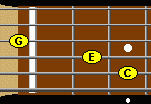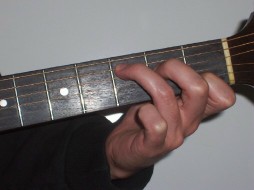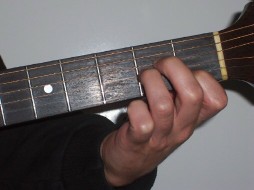| | | | | | | |
| | |
|
In
this lesson we will look at building the triads belonging to the key of C and
learn our open C and Am chord and a basic strum pattern.
Be sure to
do some finger gymnastics and review your C major scale from Lesson
2. | | | | |
| | | | | | | |
|
| |
|
| Building
Chords A chord is defined as 3 or more notes
played at the same time.
A triad is defined as 3 notes played
at the same time.
Chords are built from scales and we will start by
building the 7 triads/chords that belong to the key of C. These are known as the
diatonic triads. Start by building a major scale: |
| |
|  | | | |
| | | | | | | |
| Stack
the notes: line, line, line - space, space, space, etc. | |
| | | | | | | |
|  | |
| | | | | | | |
|
| This leaves
us with the 7 triads/chords that belong to the key of C major. 3 will be major,
3 will be minor and 1 will be diminished. More on what all that means later but
for now upper case roman numerals are used to indicate major chords/triads (I,
IV, V) and lower case roman numerals indicate minor chords/triads (ii, iii, vi)
and vii has a small circle to indicate a diminished chord/triad. Triads/chords
are major or minor depending on the distance between the root and third. We will
cover this a bit more below but a more indepth look at the difference between
major and minor chords will be in lesson 4. For now let's
look at learning to play a C major and A minor chord and how to switch between
them with ease. | | |
| | | | | | | |
|
| |
| | | | | | | |
|
| C Major
Chord
The C chord above was built by stacking line
line line starting on C. This happens to be the 1st, 3rd and 5th
degree (note) of the scale. So we say major chords/triads are
with the 1st, 3rd and 5th of the scale. If we translate this to
the fretboard we have this:
| | |
| | | | | | | |
| | | | | | |
| | | | | | | |
| It is
not easy to strum just 3 strings. By adding another 1st and 3rd degree (both an
octave higher) we can now strum strings 5 - 1. Much easier. | |
| | | | | | | |
| | | | | | | |
| | | | | | | |
| | | | | |
| | | | | | | |
|
| The low E is not
usually played because it tends to sound muddy. Block the string by gently touching
with your 3rd finger or bring your thumb up over and touch lightly enough to stop
the string from ringing. | | |
| | | | | | | |
|
| |
| | | | | | | |
|
| A Minor
Chord Build a chord from the 6th degree of the C major
scale you will find the notes A , C and E. Because the distance between A and
C is a minor 3rd (3 half steps) the chord will be called A minor. Lesson
4 will explore this much more indepth. | | |
| | | | | | | |
| | | | | |
| | | | | | | |
|
| Once again we may
want to strum more than just 3 strings. We can add our low A string and another
E (second fret of your D string). | | |
| | | | | | | |
| | | | | |
| | | | | | | |
| | | | | |
| | | | | | | |
|
| |
| | | | | | | |
|
| Progression
- chord to chord. The order in which chords are played in a tune.
Let's work on changing between the C chord and the A minor. Only your 3rd finger
will move. Your 1st and 2nd finger will stay in the same place for both chords.
The strum pattern below will have us play down strokes
for 3 quarter notes on a C chord and then you will have one quarter note rest
to make your switch to the Am chord. Remember to only move your 3rd finger. 
|
| |
| | | | | | | |
| | |
| | | | | | | |
|
| Midi
File - right click to open in new window.
Now try switching
without a quarter rest:
There is no specific midi file for
this excercise. Use the one above and play over the rest. | | |
| | | | | | | |
| | |
| | | | | | | |
|
| |
| | | | | | | |
|
| Improvising
Let's get started on improvising (spontaneously creating music). It
is a fun and important to really growing as a musician. Below is a great exercise
to get your ears really listening and the jam track is made up of the C and Am
chord progression from above.
Let's start by using just one note. Start
the jam track below and use the high C from your C major scale. Using just that
one C, listen to the way it sounds as the chords change in the jam track. Focus
on rhythm : use quarter notes, half notes, whole notes, eighth notes, rests, mix
em up.
Next let's try the same thing with our open B. Listen to how it
sounds over the C and Am chord. The B will create a little tension
over the chords. More on that later.
Then try going back and forth between the B and
C.
After you have done this for a bit continue down the scale to the
A. Listen to the sound of A over the 2 chords and then add it to your B and C
and create some lines with the 3 notes.
You get the idea, continue
down the scale. You may also want to try it with just the pentatonic scale. |
| | | | | |
| C Major | | C
Major Pentatonic | |
| | | | | |
|  | |  | |
| | | | | | | | | |
Remember a major pentatonic scale is a 5 note
scale missing the 4th and 7th degree which in this case was
the F and B. So by using the pentatonic scale you avoid two
of the notes that caused tension. That is if you want to avoid
the tension. Sometimes you may want that tension.
Listen - midi file for slower connections
or use with midi sequencer program. | | |
| | | | | | | |
|
| |
| | | | | | | |
| Practice
- Finger gymnastics
- Em to A chord
progression
- E Phyrgian (natural notes on both E strings)
-
C to Am chord progression
- C major scale in 1st position
-
C major pentatonic in 1st position and the My Girl riff
Lesson
4 | |
| | | | | | | |


















